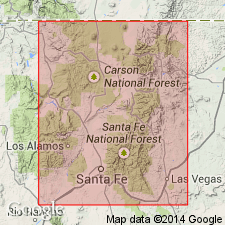
- Usage in publication:
-
- Marquenas Formation
- Modifications:
-
- Principal reference
- Dominant lithology:
-
- Quartzite
- Conglomerate
- AAPG geologic province:
-
- Southern Rocky Mountain region
Summary:
Pg. 46 (table 1), 49; see also Bauer and Helper, 1994, Geol. map Trampas quad., New Mexico Bur. Mines Min. Res. Geol. Map, no. 71, scale 1:24,000. Marquenas Formation of Vadito Group. Recognized in the Picuris Mountains of central northern New Mexico. Originally called lower conglomerate member of Vadito Formation (Montgomery, 1953). Consists of approximately equal amounts of metaconglomerate and quartzite. Thickness about 1,650 feet (500 m). Authors found no evidence to support previous study (Soegaard and Eriksson, 1986, Jour. Geol., v. 94, no. 1, p. 47-66) suggesting the Marquenas is youngest Proterozoic unit and the quartzite clasts in the Marquenas are from the Ortega. Quartzite clasts in the Marquenas lack aluminum silicate minerals, which are abundant in the Ortega. Crossbeds throughout the Marquenas indicate that it lacks major intemal folding and that stratigraphic tops are to the north. Thought to lie in upper part of Vadito Group, roughly = to Big Rock Formation of the Tusas Mountains. To north, the Marquenas underlies the Hondo Group; contact is a ductile shear zone. To south, the Marquenas is in [conformable] contact with schist of the Vadito Group; no field evidence to suggest contact is a fault. Shown on table 1 above Glenwoody Formation (new) of Vadito Group. Age is considered Early Proterozoic, ca. 1,700 Ma.
Type section: Cerro de las Marquenas in southern Picuris [Mountains], in secs. 19 and 30, T. 23 N., R. 11 E., [Trampas 7.5-min quadrangle, Taos Co., Carson National Forest area], central northern NM.
Source: Publication.
- Usage in publication:
-
- Marquenas Formation
- Modifications:
-
- Age modified
- Geochronologic dating
- Revised
- AAPG geologic province:
-
- Southern Rocky Mountain region
Jones, J.V., III, Daniel, C.G., Frei, Dirk, and Thrane, Kristine, 2011, Revised regional correlations and tectonic implications of Paleoproterozoic and Mesoproterozoic metasedimentary rocks in northern New Mexico, USA; New findings from detrital zircon studies of the Hondo Group, Vadito Group, and Marquenas Formation: Geological Society of America, Geosphere, v. 7, no. 4, p. 974-991.
Summary:
Pg. 979 (fig. 4), 981+. Marquenas Formation. Excluded from Vadito Group of Picuris Mountains, central northern New Mexico. Age modified from Paleoproterozoic --to-- Mesoproterozoic. Isotopic ages of detrital zircons, obtained from a quartzite in middle part of Marquenas and a conglomerate in upper part of Marquenas, indicate the Marquenas is younger than previously thought. Deposited, deformed, and metamorphosed between ca. 1,450 and 1,435 Ma. Is much younger than the Big Rock Formation of Vadito Group (ca. 1,700 Ma) in Tusas Mountains, central northern New Mexico (previously thought to be correlative). Shown on fig. 4 (p. 979) above the Paleoproterozoic Hondo Group, separated by a ductile shear zone (Plomo fault).
Source: Publication.
For more information, please contact Nancy Stamm, Geologic Names Committee Secretary.
Asterisk (*) indicates published by U.S. Geological Survey authors.
"No current usage" (†) implies that a name has been abandoned or has fallen into disuse. Former usage and, if known, replacement name given in parentheses ( ).
Slash (/) indicates name conflicts with nomenclatural guidelines (CSN, 1933; ACSN, 1961, 1970; NACSN, 1983, 2005, 2021). May be explained within brackets ([ ]).

